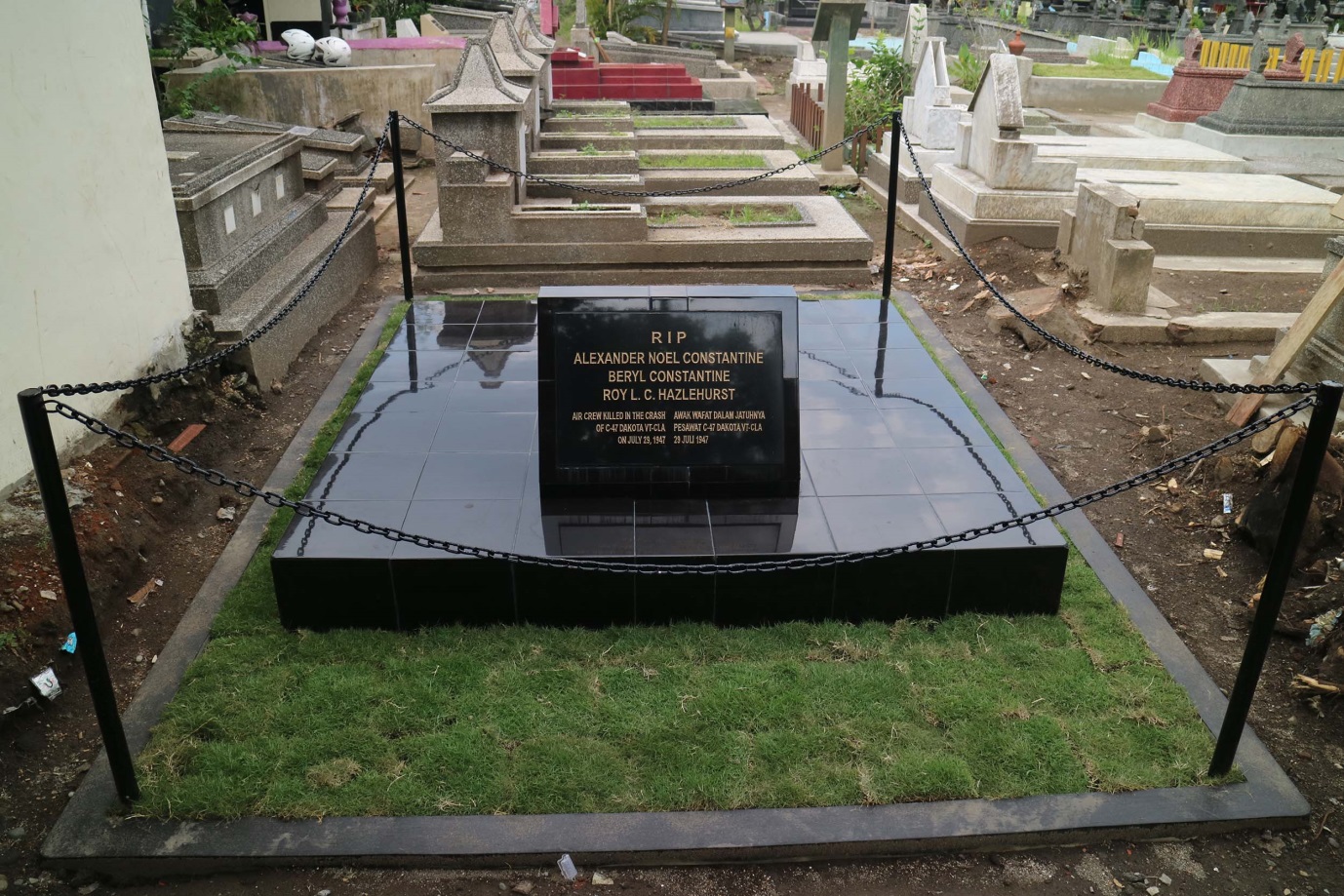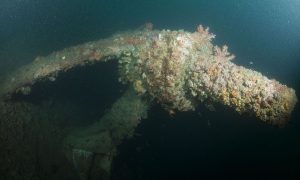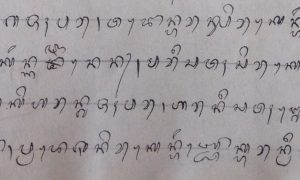Every day we are writing our own histories. Now, with social media ‘posts’, ‘tweets’ and ‘instagrams’, it is even easier to leave our mark. And though our actions may be remembered by some or forgotten by others, while we are alive we have the power to assert our identity, and affirm or correct what is said about us. But when we die, we lose control of our stories. Others can claim them, embellish them, hide them, forget them or capitalise on them. Just like the life of Noel Constantine, whose exploits continue to be reimagined to this day, by me and a few others at least, almost 70 years after his plane crashed to the ground outside Jogjakarta in Java.

Photo of Alexander Noel Constantine (Noel)
People who I see on a regular basis will have heard me mention, if not launch into a long-winded explanation, the case of Noel Constantine’s grave. I wanted to put some of my thoughts about the experience of tangentially being involved in his story in writing, because much of what has been written so far is in Indonesian. Moreover, being involved in Noel’s story, albeit indirectly, prompted me to think a lot about our stories and our histories, and what happens to them when we die.
Alexander Noel Constantine was an Australian born in Moama on the Murray River in 1914. He flew with the Royal Air Force (RAF) right through World War II, seeing action during the Battle of Britain and in Burma, amongst other theatres of war. He was regarded as an ace pilot and was decorated accordingly. After the War he set up a company in Singapore and started flying aircraft for the Indonesian Republican movement. There were a number of foreign pilots similarly engaged. In fact, the new Cathay Pacific airline had leased an aircraft to the Republicans around the same time. He would typically fly high value products like quinine and spices out of Indonesia, and return with supplies of various sorts.

DC-3 Indian Airforce (Dakota) http://www.deccanherald.com/content/514747/dakota-join-iaf-vintage-squadron.html
On July 29, 1947, Noel’s Indian owned Dakota aircraft VT-CLA was shot down by Dutch fighter planes on the outskirts of Jogjakarta. Noel’s wife Beryl was on board, and his co-pilot Roy Hazlehurst, who was an Englishman and also ex-RAF. The plane was reportedly carrying Red Cross medical supplies to the Indonesian Republican forces. Also on board was an Indian national, Bidha Ram, Zainal Arifin, the then Indonesian Consul to Malaya and Abdulgani Handokotjokro, who was the only survivor. Most significant for the Indonesians were his passengers Adi Sucipto (the Indonesian Air Force’s first pilot), Abdulrachman Saleh and Adi Sumarmo, all members of the nascent Indonesian Air Force. These three, all of whom died in the crash, are national heroes and have airports named after them in Jogja, Malang and Solo respectively. The Indonesian Air Force holds major commemorative ceremonies annually on July 29.
For me this story began in January 2016. Being in Jogjakarta for 3 weeks with an undergraduate field school, my Dad, Michael, asked me to do him a favour: Could you find the grave of Noel Constantine? He had recently been in contact with Noel’s nephew about the crash and checking on the grave site. The crux of the email—in my Dad’s very matter-of-fact tone— read:
Here is another task for you while in Jogja, maybe when you are on the road to/from Solo or Prambanan.
The above Noel Constantine was an Australian who joined the RAF in England in the 1930’s, became an air ace in the Battle of Britain , flew against the Japanese from Ceylon and India, and post WW2 started flying supplies (including guns and ammunition ) into rebel held Indonesia. After unloading his cargo in Jogja he would buy quinine/cinchona, fly that to Manilla, and sell it to the Americans before returning to Singapore to pick up more supplies for Indonesia.
His aircraft was shot down by the Dutch on approach to Jogja Airport in 1947.The crash site and monument is within 1 km or so of the airport possibly near a creek or such. His grave should be nearby. Can you find it?
Armed with this information, it took me just one day to track down the grave. When I emailed my Dad after finding the site he exclaimed that that was quick! I replied: I’m a professional researcher Dad. Finding things out is what I do for a living. See! Academics do have useful skills!
I started my search at the Air Force museum close to Adisucipto Airport. On display was a diorama of the Dakota aircraft’s crash and pictures of the Indonesian victims. No mention of Noel, Roy or Beryl in the display or elsewhere. At first I was a little confused. I thought perhaps I’d been given the wrong crash details because surely an explanation of the crash would mention who the pilot was? But it didn’t. I asked one of the museum officials if he knew about Noel, but wasn’t expecting much. Surprisingly, he knew exactly who I was talking about: ‘Oh Constantine, yes. He was the pilot. Orang Australia.’ Having found myself talking to one of the most helpful Indonesian military officials I’ve ever met, I left the museum with a map to Ngoto and the Kerkof cemetery (official known as Sasanalaya). At Ngoto, I would find the memorial; at Kerkof, the graves.
There is a very elaborate memorial at the crash site in Desa Ngoto about 5 km southeast of the Jogjakarta Keraton. The names of Noel and the other foreigners are recorded there along with those of the Indonesians who died in the crash. At Ngoto are also the graves of Abdulrachman Saleh, Adi Sumarmo and their wives. Adi Sucipto’s remains were re-interred there sometime in the early 2000s. The site is immaculately maintained, coated in marble with a grand carved mural beside. It seems a fitting final resting place for national heroes.

Tugu at Ngoto, commemorating the Dakota crash at the crash site
But it wasn’t the final resting place for Noel, Roy and Beryl or the other ‘non-national heroes’ who were on the flight. Noel’s nephew, Geoff Constantine, visited their actual burial site in 1966 to pay his respects to his fallen Uncle. At the time, the grave remained incomplete:

Photo of Noel, Beryl and Roy’s grave, 1966, curtesy of Geoff Constantine.
When I finally got to the Kerkof Cemetery later that day (and about 50 years after Geoff had been there) this is what I found:

Noel, Beryl and Roy’s grave, February 2016
The pile of leaves and the tree marked where the cemetery-managers believed Noel, Beryl and Roy to be buried. The concreting had been damaged over a decade ago, possibly in an earthquake, but nobody seemed to be quite sure. Whatever had happened, it was a big contrast from the beautiful marbled monument in Ngoto.
My Dad, with guidance and support from Geoff Constantine, undertook to rehabilitate the grave. It now looks like this:

Rehabilitated grave at Kerkof Cemetery in Jogjakarta, August 2016
Some contacts I made in early February 2016 at Tribun Jogja, were instrumental in helping with the rehabilitation, and ran a number of news articles on the story (in Indonesian), for examples click here.
I believe it gives Noel’s family great piece of mind to know that the grave has been restored. And although my involvement in this project was limited to the initial ‘finding’ of the grave site, I ended up thinking a lot about Noel, Beryl and Roy afterwards. I wondered why their deaths had been so hidden, particularly given the national significance of the flight they had been on. On the Indonesian side, Noel, Beryl and Roy had practically been written out of the Dakota story. While they had been given military honours not long after the crash, the Air Force museum neglected to mention them, the Ngoto monument had only their names. There were no photos or personal histories, unlike the rich tributes paid to Adi Sucipto, Saleh and Sumarmo. Air Force members knew who they were, but placed no importance on preserving their final resting place. The grave was decrepit and forgotten in Kerkof, covered over with weeds and junk.
To be honest, I wasn’t surprised by this lack of care or attention to grave. The Indonesians, of course, were in the midst of a fervent national-identity building project after the war for independence. What benefit could there be to highlighting that they had foreign help during their struggle against the Dutch? The Indonesian psyche was carefully being shaped to instil pride and patriotism in its citizens. There was probably little room for foreign heroes in this nationalist project. Later, even when Geoff Constantine went to visit, the grave site remained a far cry from the national heroes had, with not even a headstone. Noel, Beryl and Roy had been all but forgotten; it was simply not a priority to commemorate the ‘non-national heroes’ aboard the Dakota.
From the Australian side, my Dad had begun a concerted, but ultimately fruitless, campaign to get assistance from the Australian government to restore the grave. Noel had not been serving military personnel when he died, and even when he had served, he had been with the British, not Australian, air force. Consequently, the library at the Australian War Memorial had little interest in documenting Noel’s death. While the National Archives contained considerable information including reports on the crash and autopsies of the crash victims, a number of whom bore bullet wounds, this interest did not extend to ensuring their graves were maintained. Attempts to reach out to the Australian Embassy, including the Australian Military attaché in Jakarta about the condition of the grave were also met with little interest. This was in spite of the fact that the Australian Embassy posted on its Facebook page on 10 November 2015 a short piece on Noel and the crash to commemorate Indonesian National Heroes Day. Unfortunately, the online pride with which the Australian Embassy spoke of Noel’s sacrifice did not translate into any physical assistance with restoring the grave.
As far as the Australian government was concerned, Noel had been a private citizen who flew his plane to Indonesia and was unfortunately shot down. It was tragic, but it was his choice. Seeing as Indonesian and Australian approaches to Noel’s death left him in the lurch, I found myself wanting to see him and his fellow crash victims’ honoured. I suppose I found myself reimaging his history myself as I tried to shape the hero in my own mind. What were his motivations for flying that day? I want him to be an Australian who thought that Indonesians should be allowed to rule themselves. I want him to be the pilot who took risks to help a fledging nation attain independence despite personal danger. I want him to become a symbol of a sense of comradery and empathy that Australians have always had for our neighbours in Indonesia. And I’d like both countries to remember him, Beryl and Roy as heroes for choosing to fly into Indonesia with medical supplies knowing that they could be shot down by the Dutch. But then, is this Noel’s story or the history I’ve imagined for him?
Elisabeth is a Deputy Director at the Sydney Southeast Asia Centre at the University of Sydney. Her current research focuses on political symbolism in Indonesia, including the use of anti-corruption discourse in electoral campaigning and illicit drug policy as a battleground between political interests and scientific evidence. She also manages the Sydney Southeast Asia Centre’s New Colombo Plan program, bringing undergraduate students to study in Indonesia on a regular basis.
 Facebook
Facebook  Twitter
Twitter  Soundcloud
Soundcloud  Youtube
Youtube  Rss
Rss 


